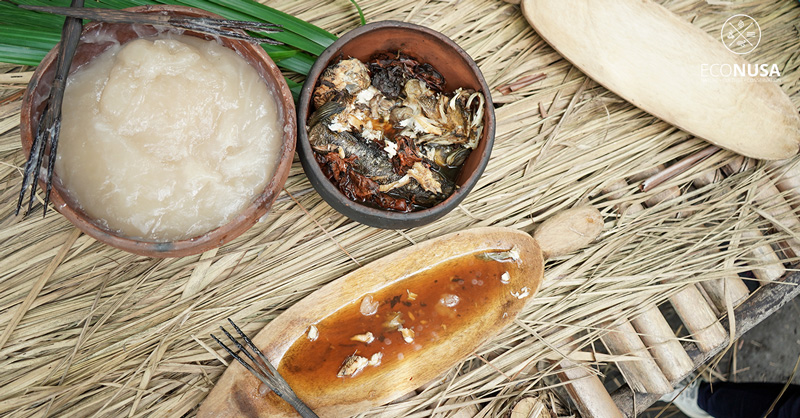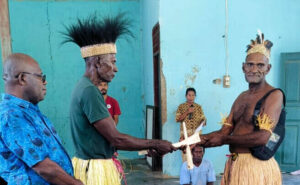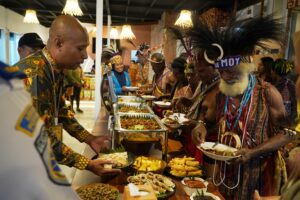
Similarly to that of in other regions in Indonesia, Tanah Papua also has traditional food and culture of traditional cooking. Charles Toto, or dubbed Chato, is a Papuan chef who is enthusiastic in promoting Papuan traditional culinary. He is the owner of Ungkea Jungle Resto, a restaurant specifically presenting Papuan traditional food that is authentically cooked on the basis of the local habits.
EcoNusa team paid a visit to the restaurant to get deeper understanding of culinary from Tanah Papua from Chato. After 10-minute walking along the path on sago jungle at Kwadeware Village in Waibu District, Jayapura Regency, Papua, there were two huts. A small signage read “Ungkea Jungle Resto” was on the front view of the restaurant.
Ungkea Jungle Resto, Adopting Sago Harvesting Culture in Sentani
Ungkea Jungle Resto is located in sago jungle surrounding Sentani Lake. The area is known as one of the centers of sago in Tanah Papua. In a book entitled Sago for the World (Sagu untuk Dunia), it was written that sago forests surrounding Sentani Lake are about 4,000-5,000 hectares of plot land with 17 varieties and 10 sub-varieties growing in this area.

Preserving Papuan food culture is the spirit behind the Ungkea Jungle Resto. The location and concept of the restaurant also adopt the local culture during they harvest sago. The hut located in the center of sago jungle adopts the local Papuan habits who make their huts in the heart of the forests as the relaxing spot during harvest time.
While showing some traditional Papuan food menus, Chato said that almost all parts of the restaurant make use of sago tree ranging from the construction up to the culinary.
“Sago has a lot of benefits. The hut is made of trunk, skin, and sago leaves. Almost all of the food is made of sago. That is called ouw (wrapped sago) as unique culinary of Sentani made of sago,” he said.
Rice and Cooking Oil are not Papuan People’s Identity
“Since 1997, I have started mapping food,” said Chato, “I made it over the sideline of my busy day taking my guests. I always make a record of vegetation in each region.”

Food mapping is one of the activities done to record food materials used by tribes in Tanah Papua. There are hundreds of vegetation types documented by Chato. However, he admitted the record is not well organized yet as he could hardly make its classifications alone.
Hundreds of trips he had made has enriched his perspective on food identity to the indigenous Papuan people. As to Chato, Papuan food identity is not rice, but sago. This identity needs to be preserved. “Indonesian community, particularly Papua, should love more local culinary. Based on my data, there is much more sago here,” he added.
During the talk, he shared his concern about sustainability of sago forests in Tanah Papua which is on the looming threat of land conversion. He took an example from developer who can convert sago forests nearby Ungkea Jungle Resto into housing complex anytime. Chato also criticized the mega project of food estate at Tanah Papua which once failed at Merauke but the government tries to revive the project.
“Sago should be aligned to other food in Indonesia such as rice. We hope sago can be promoted as the staple food. Let us promote Papua through sago, instead of replacing it with other type that does not belong to Papuan such as paddy field, palm oil and the likes,” he asserted. In addition to sago, Chato said that Papuan people also consume the existing carbohydrate from other crop such as wheat, sorghum, and foxtail millet (cereal type) at Biak Numfor.
In addition to staple food issue, Chato said there are not many people recognizing other traditional food of Papuan. The Papuan community has long had efficient traditional cooking pattern. All ingredients are cooked on the roasting stone ceremony. This distinguishes cooking process from other places in Indonesia.
“Papuan people do not have habit of frying. Traditionally we have our own way to soak oil from food. By roasting stone, we order the food in such a way meat can soak its fat. Thus, if there is palm oil estate, we do not know to whom it would be designated,” said Chato.
Long Road of Gastrodiplomacy
Introducing sago as the identity of Papuan people is one of the gastrodiplomacy missions of Charles Toto’s. He several times mentioned gastrodiplomacy to name a business he does to promote Papuan culinary at national and international levels. In international relation science, gastrodiplomacy is deemed a state effort to export culinary heritage as part of public diplomacy. It aims to make national product popular. P. S. Rockower, in his article entitled ‘Recipes for Gastrodiplomacy’, defined gastrodiplomacy as “an attempt to win over the heart and mind through tummy.”

“When I was in Turine, Italia, I joined food conference together with chefs around the globe. My target was only one, that is to introduce Papuan food. I earn my own income to get there. I cooked in my many churches to collect donation. I also made friend investment (by building network) with many peoples. It is only intended to promote Papuan food to the world,” said Chato.
Chato believed that sago and other Papuan food have potential to draw international attention. He referred to Japanese interests to Indonesian sago. “Japanese people start seriously review sage due to its healthier nutrient than rice’s. The government should have managed sago seriously, instead of replacing with other food,” Chato said.
Editor: Leo Wahyudi & V. Arnila Wulandani




